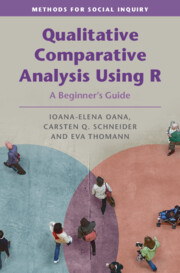1 - Introduction: QCA in a Nutshell
Published online by Cambridge University Press: 07 October 2021
Summary
This chapter uses an empirical example to explain what Qualitative Comparative Analysis (QCA) is and how it works. We familiarize the reader with the basic analytic goals and steps of QCA and the results this method produces. We also sketch the empirical spread of QCA and related software. We explain how this book is structured and how the reader can best use it.
QCA identifies necessary and sufficient conditions for an outcome by modeling core aspects of causal complexity. As QCA is a set-theoretic method, we attribute cases to sets that represent the outcome we want to explain, the conditions we assume to be relevant for this outcome, and we analyze necessary and sufficient conditions as set relations. Before the analytic moment, we design our research, conceptualize cases and sets, and transform them into ‘data’ (‘calibration’). The ‘analytic moment’ refers to the actual analyses of necessity and sufficiency. Finally, we interpret the results and check how ‘good’ they are.
Learning goals:
- Familiarity with the general analytic goals and motivations underlying the use of QCA.
- Basic understanding of the main analytic steps involved in doing a QCA.
- Basic understanding and interpretation of QCA results.
Keywords
- Type
- Chapter
- Information
- Qualitative Comparative Analysis Using RA Beginner's Guide, pp. 3 - 24Publisher: Cambridge University PressPrint publication year: 2021



